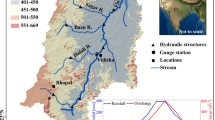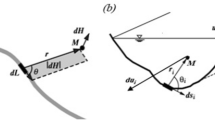Abstract
In this study, a forecasting framework for daily urban water demand has been proposed. It was developed based on the extended Kalman filter (EKF) which consists of state estimation, forecasting and error correction. The forecasting and error correction models can be substituted. As an example, a multivariate local polynomial regression (MLPR) was used to linearize the complex system which is essential for EKF. A correctional prediction of residual based on relevance vector regression was employed to update and substitute error estimation value in the EKF. To improve the precision of the forecasts, the historical data series was decomposed into low- and high-frequency subseries using discrete wavelet transformation. Five category forecasts with the lead time of 1-day were assessed in comparison of the proposed model: MLPR, multi-scale relevance vector regression, autoregressive moving average, Back Propagation neural network and multiple linear regression. According to the performance criteria, the MLPR is slightly beneficial in capturing the basic dynamics of the daily urban water demand in the short term, but the state estimation and error correction can greatly improve the results. The proposed model obtains better forecasting performances than existing models, which is attributed to good state estimation from the Kalman transmission gain and favorable feature learning performance using MLPR.






Similar content being viewed by others
References
Adamowski J, Chan FH, Prasher SO, Ozga-Zielinski B, Sliusarieva A (2012) Comparison of multiple linear and nonlinear regression, autoregressive integrated moving average, artificial neural network, and wavelet artificial neural network methods for urban water demand forecasting in Montreal, Canada. Water Resour Res 48:W01528. https://doi.org/10.1029/2010WR009945
Bai Y, Wang P, Li C, Xie J, Wang Y (2014) A multi-scale relevance vector regression approach for daily urban water demand forecasting. J Hydrol 517:236–245. https://doi.org/10.1016/j.jhydrol.2014.05.033
Bai Y, Wang P, Li C, Xie J, Wang Y (2015) Dynamic forecast of daily urban water consumption using a variable-structure support vector regression model. J Water Resour Plann Manage 141:04014058. https://doi.org/10.1061/(ASCE)WR.1943-5452.0000457
Chen G, Long T, Xiong J, Bai Y (2017) Multiple random forests modelling for urban water consumption forecasting. Water Resour Manage. https://doi.org/10.1007/s11269-017-1774-7
Ding F, Liu X, Ma X (2016) Kalman state filtering based least squares iterative parameter estimation for observer canonical state space systems using decomposition. J Comput Appl Math 301:135–143. https://doi.org/10.1016/j.cam.2016.01.042
Emmanuel AD, Thomas AM, Refik S, Roberson JA (2014) Urban water demand forecasting: review of methods and models. J Water Resour Plann Manage 140:146–159. https://doi.org/10.1061/(ASCE)WR.1943-5452.0000314
Evensen G (1994) Sequential data assimilation with a nonlinear quasi-geostrophic model using Monte Carlo methods to forecast error statistics. J Geophys Res 99:10143–10162. https://doi.org/10.1029/94JC00572
Eynard J, Grieu S, Polit M (2011) Wavelet-based multi-resolution analysis and artificial neural networks for forecasting temperature and thermal power consumption. Eng Appl Artif Intell 24:501–516. https://doi.org/10.3390/w8050197
Fan J, Gijbels I (1996) Local polynomial modelling and its applications. Chapman and Hall/CRC, London
Julier SJ, Uhlmann JK, Durrant-Whyte H (1995) A new approach for filtering nonlinear systems. In: Proceedings of the “American Control Conference”, Seattle, WA, pp 1628–1632. https://doi.org/10.1109/acc.1995.529783
Kalman RE (1960) A new approach to linear filtering and prediction problems. J Basic Eng 82:35–45
Kim HS, Eykholt R, Salas JD (1999) Nonlinear dynamics, delay times, and embedding windows. Physica D 127:48–60. https://doi.org/10.1016/S0167-2789(98)00240-1
Lee S, Chang J (2016) On using multivariate polynomial regression model with spectral difference for statistical model-based speech enhancement. J Syst Architect 64:76–85. https://doi.org/10.1016/j.sysarc.2015.10.007
Mallat GS (1989) A theory for multi resolution signal decomposition: the wavelet representation. Trans Pattern Anal Mach Intell 11:674–693
Masry E (1997) Multivariate regression estimation: local polynomial fitting for time series. Nonlinear Anal Theory Methods Appl 30:3575–3581. https://doi.org/10.1016/S0304-4149(96)00095-6
Messaci F, Nemouchi N, Ouassou I, Rachdi M (2015) Local polynomial modelling of the conditional quantile for functional data. Stat Methods Appl 24:597–622. https://doi.org/10.1007/s10260-015-0296-9
Mouatadid S, Adamowski J (2017) Using extreme learning machines for short-term urban water demand forecasting. Urban Water J 14:630–638. https://doi.org/10.1080/1573062X.2016.1236133
Rosenstein MT, Collins JJ, De Luca CJ (1994) Reconstruction expansion as a geometry-based framework for choosing proper delay times. Physica D 73:82–89. https://doi.org/10.1016/0167-2789(94)90226-7
Ruppert D, Wand PM (1994) Multivariate locally weighted least squares regression. Ann Stat 22:1346–1370. https://doi.org/10.1214/aos/1176325632
Shafaei M, Kisi O (2016) Lake level forecasting using wavelet-SVR, wavelet-ANFIS and wavelet-ARMA conjunction models. Water Resour Manag 30:79–97. https://doi.org/10.1007/s11269-015-1147-z
Stone CJ (1977) Consistent nonparametric regression. Ann Stat 5:595–620. https://doi.org/10.1214/aos/1176343886
Su L (2010) Prediction of multivariate chaotic time series with local polynomial fitting. Comput Math Appl 59:737–744. https://doi.org/10.1016/j.camwa.2009.10.019
Sun L, Nistor I, Seidou O (2015) Streamflow data assimilation in SWAT model using extended Kalman filter. J Hydrol 531:671–684. https://doi.org/10.1016/j.jhydrol.2015.10.060
Valenzuela O, Pasadas M (2011) Fuzzy data approximation using smoothing cubic splines: similarity and error analysis. Appl Math Model 35:2122–2144. https://doi.org/10.1016/j.apm.2010.11.046
Wang X, Jiang S, Yin J (2012) Data sharpening methods in multivariate local quadratic regression. J Multivar Anal 105:258–275. https://doi.org/10.1016/j.jmva.2011.09.004
Wishner R, Tabaczynski J, Athans M (1969) A comparison of three non-linear filters. Automatica 5:487–496. https://doi.org/10.1016/0005-1098(69)90110-1
Zamani A, Azimian A, Heemink A, Solomatine D (2010) Non-linear wave data assimilation with an ANN-type wind-wave model and Ensemble Kalman Filter (EnKF). Appl Math Model 34:1984–1999. https://doi.org/10.1016/j.apm.2009.10.013
Zhang H, Hu J, Zou L et al (2018) Event-based state estimation for time-varying stochastic coupling networks with missing measurements under uncertain occurrence probabilities. Int J Gen Syst 47(5):506–521. https://doi.org/10.1080/03081079.2018.1445740
Zheng X, Fang H (2015) An integrated unscented Kalman filter and relevance vector regression approach for lithium-ion battery remaining useful life and short-term capacity prediction. Reliab Eng Syst Saf 144:74–82. https://doi.org/10.1016/j.ress.2015.07.013
Acknowledgements
This work is supported by the Natural Science Foundation of China (71801044), the Humanities and Social Science Foundation of Ministry of Education of China (17YJC630003), the Natural Science Foundation of Chongqing (cstc2018jcyjAX0436), and the Research Start-Up Funds of CTBU (1756012). In addition, the authors would also like to thank the editors/reviewers for their valuable suggestions and comments that have helped improve this paper.
Author information
Authors and Affiliations
Contributions
TL and YB conceived and designed the experiments; GC performed the experiments, analyzed the data and wrote the paper; JZ contributed to the scientific discussion and editing. The authors thank JX for supplying the dataset.
Corresponding author
Ethics declarations
Conflicts of interest
The authors declare no conflict of interest.
Additional information
Publisher's Note
Springer Nature remains neutral with regard to jurisdictional claims in published maps and institutional affiliations.
Appendices
Appendix A
1.1 Wavelet Transform for Decomposition
The wavelet transform is a series mathematic function that decomposes a non-stationary time series into multiple subseries with diverse frequency domains by a mother wavelet (Daubechies ‘db’). In this study, Discrete wavelet transform (DWT) is utilized because it is easy to be implemented and more less amount of calculation. The DWT function of a time series x is simplified as following [14]
where p and q are integers that determine the magnitude of wavelet dilation and translation, respectively. Wf shows the specified wavelet coefficient of the subseries. ψ is the transforming function.
In Eq. (A.1), Wf applies down sampling to obtain an approximation coefficient (\( {\mathbf{x}}^{\text{aL}} = \{ x_{i}^{{^{\text{aL}} }} \} \)) at level L with a lowpass LP(ψ(i)), and detail coefficients (\( {\mathbf{x}}^{{{\text{d}}k}} = \{ x_{i}^{{{\text{d}}k}} \} \)) at levels k = 1, 2,…, K with a high pass filter HP(ψ(i)). Then the raw signal could be defined as
Appendix B
2.1 C–C Method for m and τ
The C–C method will be undertaken based on:
-
(1)
Compute the \( \overline{S} (t),\;\Delta \overline{S} (t) \) and \( S_{cor} (t) \) of each time subseries
$$ \overline{S} (t) = \frac{1}{4 \cdot Z}\sum\limits_{j = 1}^{4} {\sum\limits_{m \ge 2} {\Delta S(m,N,r_{j} ,t)} } $$(B.1)$$ \Delta \overline{S} (t) = \frac{1}{4}\sum\limits_{m \ge 2} {\Delta S(m,t)} $$(B.2)$$ S_{cor} (t) = \Delta \overline{S} (t) + |\overline{S} (t)| $$(B.3)where \( \Delta S(m,N,r_{j} ,t) \) and \( \Delta S(m,t) \) are statistic functions varied with m, N, time and characteristic values, see as [27, 28].
-
(2)
Select the index lag t for the first local minimum of \( \Delta \overline{S} (t) \), the global minimum of \( S_{cor} (t) \) and \( \overline{S} (t) = 0 \). Determine m and τ based on Eq. (2).
Rights and permissions
About this article
Cite this article
Chen, G., Long, T., Bai, Y. et al. A Forecasting Framework Based on Kalman Filter Integrated Multivariate Local Polynomial Regression: Application to Urban Water Demand. Neural Process Lett 50, 497–513 (2019). https://doi.org/10.1007/s11063-019-10001-3
Published:
Issue Date:
DOI: https://doi.org/10.1007/s11063-019-10001-3




